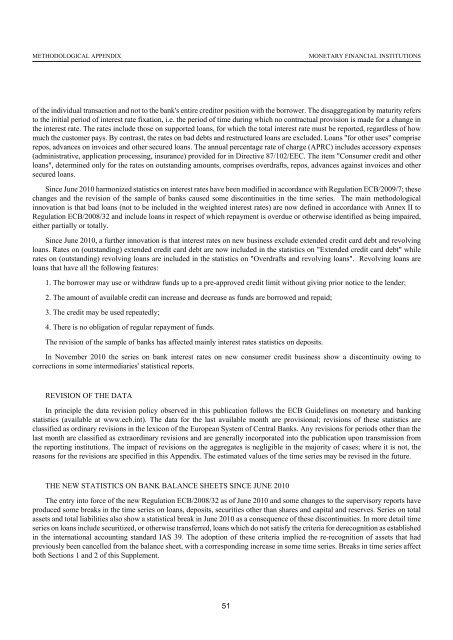78NWw9
78NWw9
78NWw9
You also want an ePaper? Increase the reach of your titles
YUMPU automatically turns print PDFs into web optimized ePapers that Google loves.
METHODOLOGICAL APPENDIX<br />
MONETARY FINANCIAL INSTITUTIONS<br />
of the individual transaction and not to the bank's entire creditor position with the borrower. The disaggregation by maturity refers<br />
to the initial period of interest rate fixation, i.e. the period of time during which no contractual provision is made for a change in<br />
the interest rate. The rates include those on supported loans, for which the total interest rate must be reported, regardless of how<br />
much the customer pays. By contrast, the rates on bad debts and restructured loans are excluded. Loans "for other uses" comprise<br />
repos, advances on invoices and other secured loans. The annual percentage rate of charge (APRC) includes accessory expenses<br />
(administrative, application processing, insurance) provided for in Directive 87/102/EEC. The item "Consumer credit and other<br />
loans", determined only for the rates on outstanding amounts, comprises overdrafts, repos, advances against invoices and other<br />
secured loans.<br />
Since June 2010 harmonized statistics on interest rates have been modified in accordance with Regulation ECB/2009/7; these<br />
changes and the revision of the sample of banks caused some discontinuities in the time series. The main methodological<br />
innovation is that bad loans (not to be included in the weighted interest rates) are now defined in accordance with Annex II to<br />
Regulation ECB/2008/32 and include loans in respect of which repayment is overdue or otherwise identified as being impaired,<br />
either partially or totally.<br />
Since June 2010, a further innovation is that interest rates on new business exclude extended credit card debt and revolving<br />
loans. Rates on (outstanding) extended credit card debt are now included in the statistics on "Extended credit card debt" while<br />
rates on (outstanding) revolving loans are included in the statistics on "Overdrafts and revolving loans". Revolving loans are<br />
loans that have all the following features:<br />
1. The borrower may use or withdraw funds up to a pre-approved credit limit without giving prior notice to the lender;<br />
2. The amount of available credit can increase and decrease as funds are borrowed and repaid;<br />
3. The credit may be used repeatedly;<br />
4. There is no obligation of regular repayment of funds.<br />
The revision of the sample of banks has affected mainly interest rates statistics on deposits.<br />
In November 2010 the series on bank interest rates on new consumer credit business show a discontinuity owing to<br />
corrections in some intermediaries' statistical reports.<br />
REVISION OF THE DATA<br />
In principle the data revision policy observed in this publication follows the ECB Guidelines on monetary and banking<br />
statistics (available at www.ecb.int). The data for the last available month are provisional; revisions of these statistics are<br />
classified as ordinary revisions in the lexicon of the European System of Central Banks. Any revisions for periods other than the<br />
last month are classified as extraordinary revisions and are generally incorporated into the publication upon transmission from<br />
the reporting institutions. The impact of revisions on the aggregates is negligible in the majority of cases; where it is not, the<br />
reasons for the revisions are specified in this Appendix. The estimated values of the time series may be revised in the future.<br />
THE NEW STATISTICS ON BANK BALANCE SHEETS SINCE JUNE 2010<br />
The entry into force of the new Regulation ECB/2008/32 as of June 2010 and some changes to the supervisory reports have<br />
produced some breaks in the time series on loans, deposits, securities other than shares and capital and reserves. Series on total<br />
assets and total liabilities also show a statistical break in June 2010 as a consequence of these discontinuities. In more detail time<br />
series on loans include securitized, or otherwise transferred, loans which do not satisfy the criteria for derecognition as established<br />
in the international accounting standard IAS 39. The adoption of these criteria implied the re-recognition of assets that had<br />
previously been cancelled from the balance sheet, with a corresponding increase in some time series. Breaks in time series affect<br />
both Sections 1 and 2 of this Supplement.<br />
51


